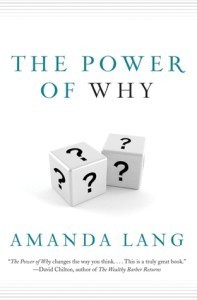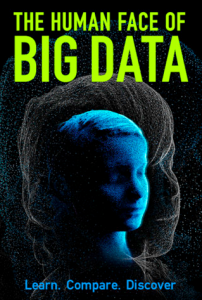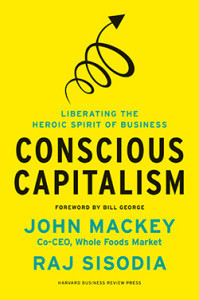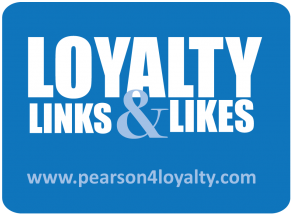Bryan Pearson's Blog, page 50
February 11, 2013
Dog-Eared and Engaging: What’s on My Bookshelf
Reading without reflecting is like eating without digesting - Edmund Burke, Irish statesman
It’s funny, but becoming an author for some reason helps establish you as a critic. After my book The Loyalty Leap came out, I noticed that friends and strangers were suddenly interested in what was sitting on my bedside table. As if writing my own book had made me a man of letters.
But what the heck. I do in fact have several books on my bedside table, my desk and my iPad. I happen to be reading a couple that are intriguing enough to warrant an early shout out. A third book is on my short list, and I am eager to get to it. So if you want the opinion of a loyalty marketer, here is what I am recommending:
 The Power of Why, by Amanda Lang
The Power of Why, by Amanda Lang
I had the pleasure of meeting Amanda Lang recently when I appeared on the CBC show Lang and O’Leary Exchange to discuss hockey fan loyalty following the end of the NHL strike. Lang’s book challenges the reader to use a basic childhood trait, curiosity, to improve creativity and innovation. Built around simple but solid concepts (one chapter is titled “Talk to Strangers”) Lang explores the power of curiosity through the insights of innovation gurus, little-known research, the experiences of business leaders and her own candid stories of life off-camera. This book explains how asking the right questions can change the world and how it can change you, too.
 The Human Face of Big Data, by Rick Smolan and Jennifer Erwitt
The Human Face of Big Data, by Rick Smolan and Jennifer Erwitt
Did you know that 60 percent of all human beings are active texters? And that one in three American babies has an online presence before it is even born? These tidbits and others are among the revelations in this literally big book of data. Coffee table sized and beautifully designed, it is a visual feast of factoids, photographs and infographics that illustrate how our world is being transformed by the way that we capture, share and analyze data. I plan to refer to this book often as a resource guide while I prepare for speeches, blog posts and even dinner conversations.
 Conscious Capitalism, by John Mackey, Whole Foods CEO
Conscious Capitalism, by John Mackey, Whole Foods CEO
In this book, the co-founder of Whole Foods Market promotes free-market thinking while also criticizing Wall Street. John Mackey’s denunciation of Obamacare has attracted a lot of press coverage, but his main message is that of conscious capitalism, which honors ethics, nobility and other business missions besides profit. A high priority is applied not only to shareholders but also to stakeholders such as customers, suppliers and employees. Mackey calls this “the secret to sustained high performance,” and I believe it. Conscious capitalism is what led us to create Air Miles for Social Change, which through the AIR MILES Reward Program encourages members to live healthier, greener lifestyles.
This is a short list, but I plan to add more to my blog bookshelf every few weeks. In the meantime I’d be interested in knowing what’s on your reading list, as well as your thoughts on these books and others.
As Mark Twain said: The public is the only critic whose opinion is worth anything at all.
February 6, 2013
February 6: Loyalty Links & Likes
 Here are a few loyalty links that caught my eye this week.
Here are a few loyalty links that caught my eye this week.
1. Customer loyalty? There’s an app for that — PilotOnline.com
Belly is getting even more face time. The story sheds more light on how the company caters to smaller businesses with loyalty program solutions.
2. Target card arrival forces Canadian retailers to step up customer data collection tactics — Canada.com
The author explains why Target’s loyalty program trumps other Canadian retailers’ programs. Here’s a hint, the answer is simple.
3. 7 Customer Service Lessons From A Jedi Master — B2C
Turns out Star Wars can teach us a bit more than just the ways of the force.
4. Brussels ‘fed up’ at Silicon Valley pressure to soften privacy laws — Financial Times
This article gets at the value of customer data by highlighting a privacy law debate spearheaded by Google and Facebook.
5. Warning: Is Your New Customer Coming Back? 4 Steps You Should Take Now — Forbes
Courting new customers is all well and good, but how can companies keep these new customers and win their loyalty? You’ll find a few ways here.
February 4, 2013
The Consumer as Test Subject
 Ask a shopper why she buys Swiss cheese, and she may tell you it’s for the nutty taste. But put her in a maze with a bunch of other people who also buy Swiss cheese, and her motivation will likely change.
Ask a shopper why she buys Swiss cheese, and she may tell you it’s for the nutty taste. But put her in a maze with a bunch of other people who also buy Swiss cheese, and her motivation will likely change.
Such is the theory put forth by Steve Martin, author of the book “Yes! 50 Scientifically Proven Ways to be Persuasive.” In a recent blog, smartly titled “Stop Listening to Your Customers,” Steve suggests marketers stop asking consumers for their opinion and instead do small experiments. The reason? Because people often do not know why they do the things they do; or they at least won’t give the true reason why.
This is along the lines of the say-do factor outlined in a recent study by LoyaltyOne, called Customer Data — Privacy, Profit and the New Paradigm. The hypothesis is that people often say they believe one thing while doing another. For example, someone might say he does not want to be tracked on his mobile device, yet he is signed up for a variety of apps that do just that. Likewise, if you asked someone what would motivate her to recycle, she might say she’d do it to save the planet, when in reality peer pressure would more likely do the trick.
Martin is not alone in his thoughts. They align with the theories of leading behavioral economist Dan Ariely, author of several books on consumer decision-making including “Predictably Irrational.” In the book, Ariely explores how moral codes, emotions and peer pressure affect our ability to make rational and often important decisions, often indirect opposition to what is in our own best interest.
If this is the way consumers behave, Martin surmises, then let’s change the marketing approach. Instead of asking a lot of questions, he encourages marketers to set up small field tests through which they can gather insights by observing what people do. Great idea. In fact, I’d take the experiments a step further and suggest using a consumer measurement device, such as a loyalty program, to provide the windows into their behavior in such experiments.
Do more people buy earth-friendly detergent when the messaging is about saving the planet, or when the message is “buy green and earn double points”? Is a traveler from the East coast more likely to choose a hotel room that comes with free breakfast, or the same room with free parking?
Past behavior has always been a strong, even if not perfect, predictor or future behavior. By combining past behavior with structured experiments, it becomes a powerful asset as an organization refines its brand experience and offers. That is cheese worth taking a chance on.
January 30, 2013
January 30: Loyalty Links & Likes
 Here are a few loyalty links that caught my eye this week.
Here are a few loyalty links that caught my eye this week.
1. Belly’s New ‘Belly Bites’ Let You Sample Free Haircuts, Pizza, Gym Membersships — Fast Company
The digital loyalty company is back in the news for working with companies in creating free sample offers.
2. Mr. P’s owner shares tips on building customer loyalty — Birmingham Business Journal
A deli owner in Alabama provides some small business insight into building customer loyalty.
3. Soon, airline loyalty will cost you — Chicago Tribune
The reporter examines Delta’s latest loyalty program changes through both a customer and business lens.
4. Bank of America knows its customer service is awful — MSN Money
This story highlights a recent letter from the bank’s CEO urging employees to be nicer in order to win customer loyalty.
5. Thank You Cards and Doughnuts — Forbes
The author shares a lesson in loyalty he learned from a fellow college classmate. Simply put, a little personalized customer appreciation can go a long way.
January 28, 2013
French Made: Tax on Data Could Cause Dust Up

Gerard Depardieu
Photo: AFP/Getty Images
If there is one thing the French government is not laissez-faire about these days, it is taxes. But its recent proposal to attach tariffs to personal information is more a faux pas than a fix.
This is what French regulators are exploring, as explained in a recent story in The New York Times. The government, cash-strapped and looking for ways to raise revenue, is proposing an Internet tax on the collection of consumer data.
This is not an arbitrary choice. In addition to raising money, the levy would resolve what the government sees as tax avoidance by Internet giants such as Facebook, Amazon and Google, all of which collect warehouses of personal data regularly. According the NYT story, Google alone generates more than $30 billion a year in advertising revenue, $2 billion of which is in France. Yet it and other American Internet companies pay almost no taxes there.
“The report published Friday said a tax on data collection was justified on grounds that users of services like Google and Facebook are, in effect, working for these companies without pay by providing the personal information that lets them sell advertising,” the NYT story stated.
Put another way, someone’s personal musical preferences, payment preferences or Facebook “likes” should come with a price tag.
We know Gerard Depardieu has left the country due to taxation concerns, but is France really prepared to go after foreign corporations? Any legislation is far off, but the idea of taxing personal data is akin to limiting the ability of digital companies to use that information to create relevant customer experiences. It cuts into competition.
Sure, in a data hungry world, such an action would take advantage of the implicit value exchange that’s been occurring on the web for the past decade or so. But at the same time, wouldn’t it rob the consumer of a richer experience?
The idea of taxing data most likely has online companies shouting, “mon dieu!” My suggestion, when it comes to taxing material as beneficial and fluent as data, is mon don’t.
January 25, 2013
January 25: Loyalty Links & Likes
 Here are a few loyalty links that caught my eye this week.
Here are a few loyalty links that caught my eye this week.
1. When driving customer loyalty, less is more — Retail Customer Experience
This story offers five tips to streamlining loyalty programs and creating memorable rewards.
2. Case Study: New Loyalty Program Connects ‘Wichcraft With Customers — Street Fight
The speciality sandwich service ‘wichcraft is going mobile with its loyalty program. This story provides a Q&A with ‘wichcraft’s marketing director.
3. Luka Apps, 7-Year-Old Boy, Writes Letter To Lego, Gets His Toy Replaced — Huffington Post
LEGO demonstrates superior customer service in what some are calling the best customer service story of 2013.
4. Kiip mobile rewards platform arrives in Japan with campaign for Ponta loyalty program — The Next Web
A reward service for mobile apps is partnering with a local loyalty program to kickoff its entry into the Japanese market.
5. Travelers get stingier with their loyalty — USA Today
A new survey says only 8 percent of travelers are loyal to a hotel brand and only 14 percent are loyal to an airline. The reporter explores the survey’s implications for hotels and airlines.
January 22, 2013
2013 THIA Annual Conference
The Loyalty Leap: Turning Customer Information into Customer Intimacy
A lot of marketers can brag they have millions of loyalty members, but how many of their customers are truly loyal? Winning the customer’s trust and emotional dedication takes more than points and plastic; it requires a steadfast commitment to understanding the needs and aspirations of your customers and then building your business purpose around that. Such commitment is why almost 99.9% of Canada’s 10 million AIR MILES Collectors willingly share their personal information with LoyaltyOne, one of the largest loyalty companies on earth.
In this illuminating presentation, Bryan Pearson will provide a sneak peak into the stories and strategies highlighted in his bestselling book, The Loyalty Leap: Turning Customer Information into Customer Intimacy. Drawing on 20 years of firsthand experience and research, Bryan will share his secrets to building customer intimacy in an information age while also navigating the minefields of privacy. From weathering the major forces that are altering marketing to empowering employees through customer data, Bryan will provide the tools to make the Loyalty Leap.
• Building relevant communications that engage consumers when they want, wherever they are
• The common myths behind the privacy debate and a challenge to critics who equate data-usage marketing with for-profit spying
• The powerful strength of Enterprise Loyalty
• How to close the customer commitment gap through meaningful communications
• The difference between customer intimacy and loyalty, and how to use it to drive growth
Loyalty World Canada
Trust or Bust: Using Loyalty to Create Winning Customer Experiences
- At a time when privacy concerns are heightened, is there a way to win the public’s trust?
- How to use data to create relevant communications that connect with consumers
- How to turn customer information into customer intimacy through a value exchange
- Results of recent survey of consumer attitudes about data and privacy. What crosses the barrier from clever to creepy?
January 21, 2013
Business Standard: Hope, not fear, builds bridges
Author Bryan Pearson tells Ankita Rai that loyalty is the result of customer intimacy, not anxiety.
Marketing through fear and hope can succeed in selling products, but can it build brand loyalty as well?
Absolutely! But what I propose is that while marketers rely heavily on fear to sell products, it is hope that builds loyalty. Many of our most basic fears stem from our instinct to survive a fear of chaos, strangers, the unknown, insignificance and death. These fears have successfully been tapped to sell all kinds of products, from hair growth medications to security alarm systems to hand sanitation products. But unless the message of fear delivers a positive association with your brand, it will not generate loyalty. Loyalty is the result of customer intimacy, not anxiety. Shape the product and the message around the customers’ belief systems and ambitions. What this all points to is the big ‘R’: relevance.
How do marketers draw customers’ attention in a diffuse environment?
Well, a lot of marketers try to achieve this through loyalty programmes. Many companies launch loyalty programmes to collect customer data. But the programme is just the first step; it is merely the mechanism for gathering the data. The trick for marketers is extracting from that information the insights that will help them engage the consumer in a relevant way (again, the Big R). The first step to achieve this is by becoming customer committed. The organisation has to put the customer at the centre of its purpose and then base every decision on what is meaningful to that consumer. Customer-committed organisations enter into two-way dialogues with their patrons and use a balance of data and innovation to design an experience that is meaningful.
How should companies use customer data effectively, without violating privacy?
Privacy is a big issue in India. Almost 40 per cent of India’s middle-income earners said they have not joined a loyalty programme due to privacy concerns, according to research by COLLOQUY, LoyaltyOne research group. Companies should think of data collection as a transaction. If you expect the customer to share personal information with you, you need to provide something of equal or greater value in return. You are accountable for that data and how it is used.
Be transparent and reasonable about what you collect and why you collect it. Never cross the creepy line into the ultra-personal areas such as financial information or questions about children. And always, always destroy data with care.
Between behavioural loyalty and emotional loyalty, what wins and why?
An emotionally loyal customer will stay with your brand even when a comparable or more convenient alternative is made available. Behavioural loyalty is motivated by rewards. It occurs when the customer is conditioned to visit a specific store based on the motivation of price or promotions. But as soon as a more attractive alternative opens up, she will likely see if it is more convenient or price competitive. And if so, that consumer will shift brands. Good-bye, loyalty.
Emotional loyalty is gained when the brand proves itself by providing communications and services that are relevant to that consumer’s needs, on a timely basis. It is a matter of gaining trust, which is hard won but worth it.
From Playing Favorites to Tierful Choices: Six Resolutions for Winning Savvy Consumers in 2013
 If one word could describe consumers in 2012 it would be smart – smart phones, smarter transaction processing and smart mobile wallets. Now, with 2013 before us, I project consumers will take “smart” one step further, to savvy.
If one word could describe consumers in 2012 it would be smart – smart phones, smarter transaction processing and smart mobile wallets. Now, with 2013 before us, I project consumers will take “smart” one step further, to savvy.
We, as marketers, can help. Think about it. Consumers have a host of mobile apps and digital services to do their comparison-shopping, pricing and even purchasing. But how informed are our customers when it comes to the guidelines of their loyalty programs? If the average household belongs to 18 loyalty programs but participates in only eight – as COLLOQUY, LoyaltyOne’s research group, has determined – then it is not earning and redeeming at optimum levels.
A customer who feels he or she is getting the short end of a brand transaction will not become loyal. So with that in mind, here are six resolutions I expect the savvy consumer will take in 2013, and the role smart marketers can play:
Play favorites: Savvy consumers will analyze where they spend their money and then consolidate as much purchasing as possible under the programs that yield the most relevant rewards. They also will calculate how many points or miles will be needed to get that desired reward, and how long it will take. The programs that offer the most options for gaining and redeeming tailored rewards, easily, will earn this business.
Avoid expiration exasperation: Once the consumer has calculated how long it will take to earn a specific reward, the next step will be to ensure the currency won’t expire before reaching that goal. Since program operators sometimes change their policies regarding expiration, savvy consumers will pay attention to all program communications to avoid being blind-sided. So make that communication clear, and clearly to the consumer’s benefit.
Pick partners: Merchant loyalty programs that give points to members who shop with a complementary business, such as supermarkets with gas stations, can yield faster rewards. But the savvy shopper will figure out that this only works if he or she uses the products and services of each business enough to generate those perks. To stimulate that business, marketers should invest in unique, cross-promotional spending opportunities, such as double fuel points for buying organic foods.
Look beyond the dollar: Consumers are pretty much conditioned to accumulate points. But with many credit cards offering just 1 percent to 3 percent back, savvy shoppers will quickly find that non-monetary rewards can be of greater value. Such perks might include apparel alterations, free Wi-Fi, access to airline lounges and complimentary hotel nights.
Make tierful choices: Lots of airlines, hotels and department store chains offer reward programs with silver, gold and platinum tiers. The higher the tier, the better the perks. This is great aspirational marketing, but the savvy consumer will ask: Can I achieve that tier ranking at my spending level? Loyalty programs can make it easy to run the math and see what it takes to advance, while offering spending options to get there (two Halston dresses + three Kate Spade bags = one Burberry scarf).
Don’t be a stranger: Lastly, marketers should make it so consumers can easily stay in touch with their rewards. Savvy loyalty members will choose programs that allow them to track point balances and redeem for rewards in ways that are convenient to their lifestyles. If a member stores her shopping lists on her smartphone, for example, she will prefer digital rewards to paper coupons. Likewise, savvy consumers will keep their eyes peeled for new ways to earn rewards, such as through social media activity or healthy lifestyle activities.
I am sure 2013 will deliver us a wonder of smart technologies and services. It is the marketer’s job to understand the aspirations and motivations that inform consumer decisions with each. Because regardless of the year, the savvy consumer is the smart choice.
Bryan Pearson's Blog
- Bryan Pearson's profile
- 4 followers



